Longfei Zheng
Ring-lite: Scalable Reasoning via C3PO-Stabilized Reinforcement Learning for LLMs
Jun 18, 2025Abstract:We present Ring-lite, a Mixture-of-Experts (MoE)-based large language model optimized via reinforcement learning (RL) to achieve efficient and robust reasoning capabilities. Built upon the publicly available Ling-lite model, a 16.8 billion parameter model with 2.75 billion activated parameters, our approach matches the performance of state-of-the-art (SOTA) small-scale reasoning models on challenging benchmarks (e.g., AIME, LiveCodeBench, GPQA-Diamond) while activating only one-third of the parameters required by comparable models. To accomplish this, we introduce a joint training pipeline integrating distillation with RL, revealing undocumented challenges in MoE RL training. First, we identify optimization instability during RL training, and we propose Constrained Contextual Computation Policy Optimization(C3PO), a novel approach that enhances training stability and improves computational throughput via algorithm-system co-design methodology. Second, we empirically demonstrate that selecting distillation checkpoints based on entropy loss for RL training, rather than validation metrics, yields superior performance-efficiency trade-offs in subsequent RL training. Finally, we develop a two-stage training paradigm to harmonize multi-domain data integration, addressing domain conflicts that arise in training with mixed dataset. We will release the model, dataset, and code.
Federated Learning on Non-iid Data via Local and Global Distillation
Jun 26, 2023



Abstract:Most existing federated learning algorithms are based on the vanilla FedAvg scheme. However, with the increase of data complexity and the number of model parameters, the amount of communication traffic and the number of iteration rounds for training such algorithms increases significantly, especially in non-independently and homogeneously distributed scenarios, where they do not achieve satisfactory performance. In this work, we propose FedND: federated learning with noise distillation. The main idea is to use knowledge distillation to optimize the model training process. In the client, we propose a self-distillation method to train the local model. In the server, we generate noisy samples for each client and use them to distill other clients. Finally, the global model is obtained by the aggregation of local models. Experimental results show that the algorithm achieves the best performance and is more communication-efficient than state-of-the-art methods.
Privacy Inference-Empowered Stealthy Backdoor Attack on Federated Learning under Non-IID Scenarios
Jun 13, 2023



Abstract:Federated learning (FL) naturally faces the problem of data heterogeneity in real-world scenarios, but this is often overlooked by studies on FL security and privacy. On the one hand, the effectiveness of backdoor attacks on FL may drop significantly under non-IID scenarios. On the other hand, malicious clients may steal private data through privacy inference attacks. Therefore, it is necessary to have a comprehensive perspective of data heterogeneity, backdoor, and privacy inference. In this paper, we propose a novel privacy inference-empowered stealthy backdoor attack (PI-SBA) scheme for FL under non-IID scenarios. Firstly, a diverse data reconstruction mechanism based on generative adversarial networks (GANs) is proposed to produce a supplementary dataset, which can improve the attacker's local data distribution and support more sophisticated strategies for backdoor attacks. Based on this, we design a source-specified backdoor learning (SSBL) strategy as a demonstration, allowing the adversary to arbitrarily specify which classes are susceptible to the backdoor trigger. Since the PI-SBA has an independent poisoned data synthesis process, it can be integrated into existing backdoor attacks to improve their effectiveness and stealthiness in non-IID scenarios. Extensive experiments based on MNIST, CIFAR10 and Youtube Aligned Face datasets demonstrate that the proposed PI-SBA scheme is effective in non-IID FL and stealthy against state-of-the-art defense methods.
Towards Scalable and Privacy-Preserving Deep Neural Network via Algorithmic-Cryptographic Co-design
Dec 17, 2020



Abstract:Deep Neural Networks (DNNs) have achieved remarkable progress in various real-world applications, especially when abundant training data are provided. However, data isolation has become a serious problem currently. Existing works build privacy preserving DNN models from either algorithmic perspective or cryptographic perspective. The former mainly splits the DNN computation graph between data holders or between data holders and server, which demonstrates good scalability but suffers from accuracy loss and potential privacy risks. In contrast, the latter leverages time-consuming cryptographic techniques, which has strong privacy guarantee but poor scalability. In this paper, we propose SPNN - a Scalable and Privacy-preserving deep Neural Network learning framework, from algorithmic-cryptographic co-perspective. From algorithmic perspective, we split the computation graph of DNN models into two parts, i.e., the private data related computations that are performed by data holders and the rest heavy computations that are delegated to a server with high computation ability. From cryptographic perspective, we propose using two types of cryptographic techniques, i.e., secret sharing and homomorphic encryption, for the isolated data holders to conduct private data related computations privately and cooperatively. Furthermore, we implement SPNN in a decentralized setting and introduce user-friendly APIs. Experimental results conducted on real-world datasets demonstrate the superiority of SPNN.
ASFGNN: Automated Separated-Federated Graph Neural Network
Nov 06, 2020



Abstract:Graph Neural Networks (GNNs) have achieved remarkable performance by taking advantage of graph data. The success of GNN models always depends on rich features and adjacent relationships. However, in practice, such data are usually isolated by different data owners (clients) and thus are likely to be Non-Independent and Identically Distributed (Non-IID). Meanwhile, considering the limited network status of data owners, hyper-parameters optimization for collaborative learning approaches is time-consuming in data isolation scenarios. To address these problems, we propose an Automated Separated-Federated Graph Neural Network (ASFGNN) learning paradigm. ASFGNN consists of two main components, i.e., the training of GNN and the tuning of hyper-parameters. Specifically, to solve the data Non-IID problem, we first propose a separated-federated GNN learning model, which decouples the training of GNN into two parts: the message passing part that is done by clients separately, and the loss computing part that is learnt by clients federally. To handle the time-consuming parameter tuning problem, we leverage Bayesian optimization technique to automatically tune the hyper-parameters of all the clients. We conduct experiments on benchmark datasets and the results demonstrate that ASFGNN significantly outperforms the naive federated GNN, in terms of both accuracy and parameter-tuning efficiency.
Privacy-Preserving Graph Neural Network for Node Classification
May 25, 2020



Abstract:Recently, Graph Neural Network (GNN) has achieved remarkable progresses in various real-world tasks on graph data, consisting of node features and the adjacent information between different nodes. High-performance GNN models always depend on both rich features and complete edge information in graph. However, such information could possibly be isolated by different data holders in practice, which is the so-called data isolation problem. To solve this problem, in this paper, we propose a Privacy-Preserving GNN (PPGNN) learning paradigm for node classification task, which can be generalized to existing GNN models. Specifically, we split the computation graph into two parts. We leave the private data (i.e., features, edges, and labels) related computations on data holders, and delegate the rest of computations to a semi-honest server. We conduct experiments on three benchmarks and the results demonstrate that PPGNN significantly outperforms the GNN models trained on the isolated data and has comparable performance with the traditional GNN trained on the mixed plaintext data.
Industrial Scale Privacy Preserving Deep Neural Network
Mar 12, 2020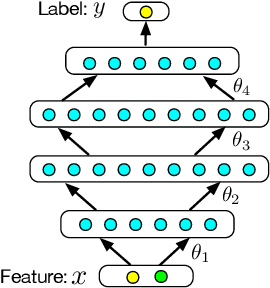
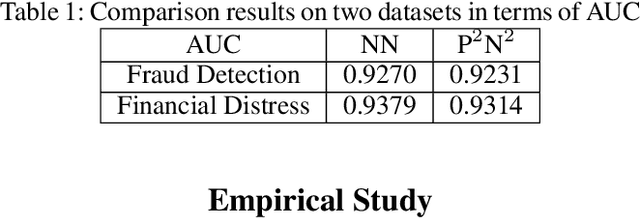
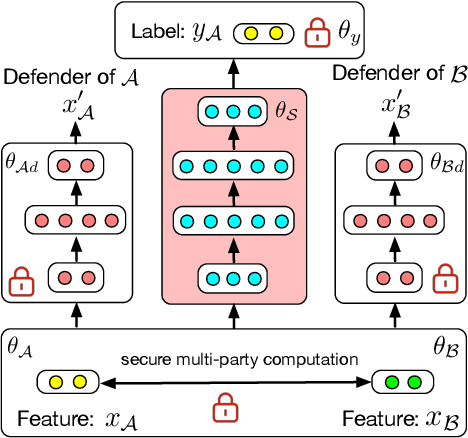
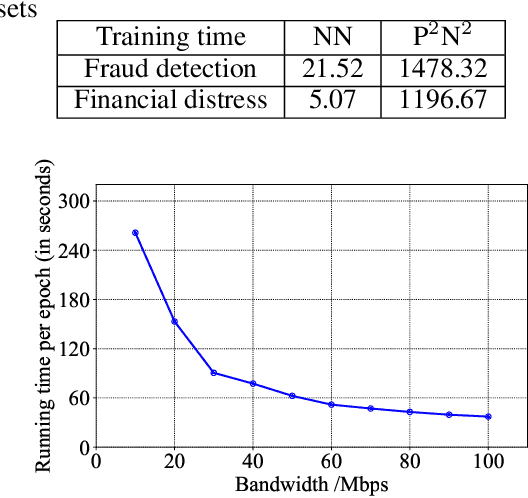
Abstract:Deep Neural Network (DNN) has been showing great potential in kinds of real-world applications such as fraud detection and distress prediction. Meanwhile, data isolation has become a serious problem currently, i.e., different parties cannot share data with each other. To solve this issue, most research leverages cryptographic techniques to train secure DNN models for multi-parties without compromising their private data. Although such methods have strong security guarantee, they are difficult to scale to deep networks and large datasets due to its high communication and computation complexities. To solve the scalability of the existing secure Deep Neural Network (DNN) in data isolation scenarios, in this paper, we propose an industrial scale privacy preserving neural network learning paradigm, which is secure against semi-honest adversaries. Our main idea is to split the computation graph of DNN into two parts, i.e., the computations related to private data are performed by each party using cryptographic techniques, and the rest computations are done by a neutral server with high computation ability. We also present a defender mechanism for further privacy protection. We conduct experiments on real-world fraud detection dataset and financial distress prediction dataset, the encouraging results demonstrate the practicalness of our proposal.
Privacy Preserving PCA for Multiparty Modeling
Feb 09, 2020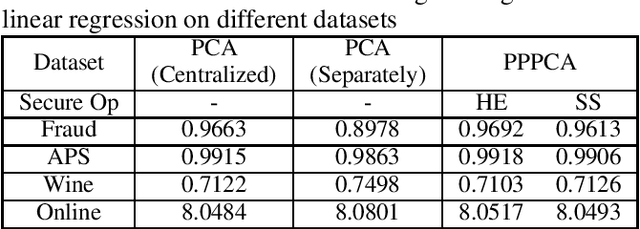


Abstract:In this paper, we present a general multiparty modeling paradigm with Privacy Preserving Principal Component Analysis (PPPCA) for horizontally partitioned data. PPPCA can accomplish multiparty cooperative execution of PCA under the premise of keeping plaintext data locally. We also propose implementations using two techniques, i.e., homomorphic encryption and secret sharing. The output of PPPCA can be sent directly to data consumer to build any machine learning models. We conduct experiments on three UCI benchmark datasets and a real-world fraud detection dataset. Results show that the accuracy of the model built upon PPPCA is the same as the model with PCA that is built based on centralized plaintext data.
 Add to Chrome
Add to Chrome Add to Firefox
Add to Firefox Add to Edge
Add to Edge